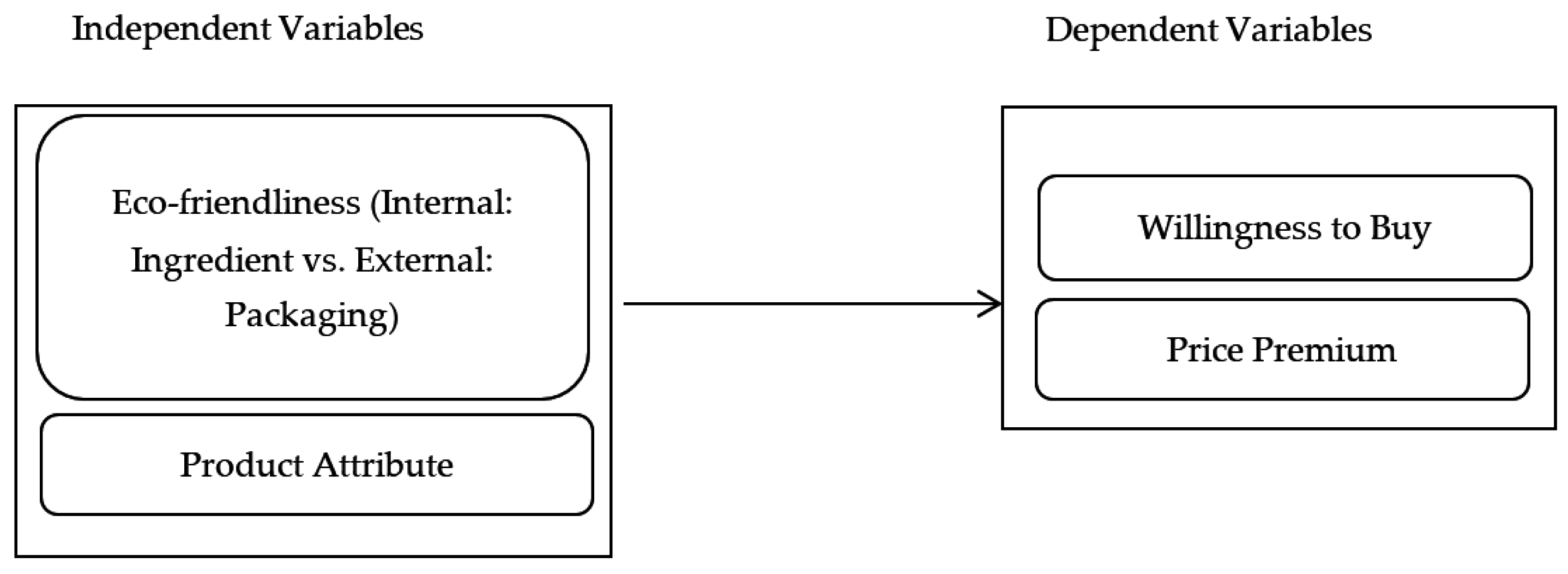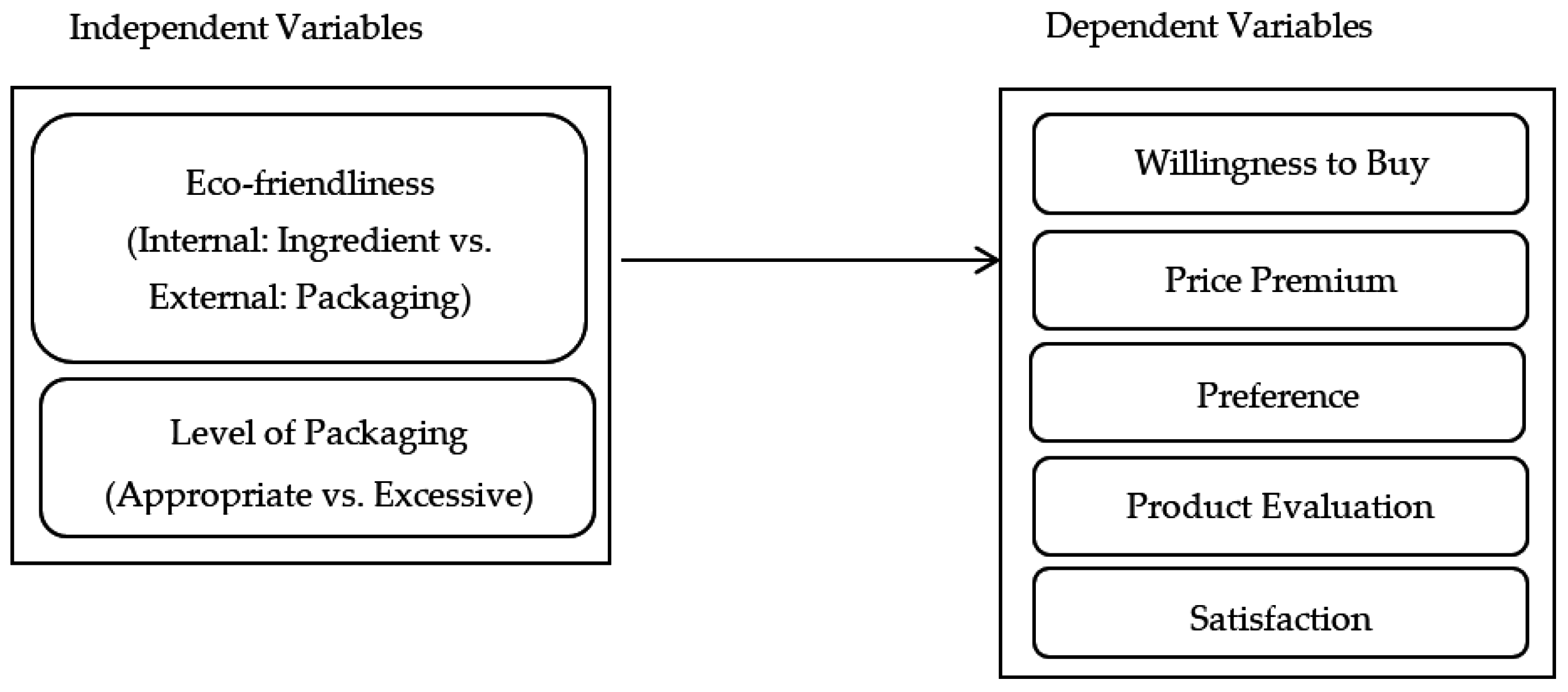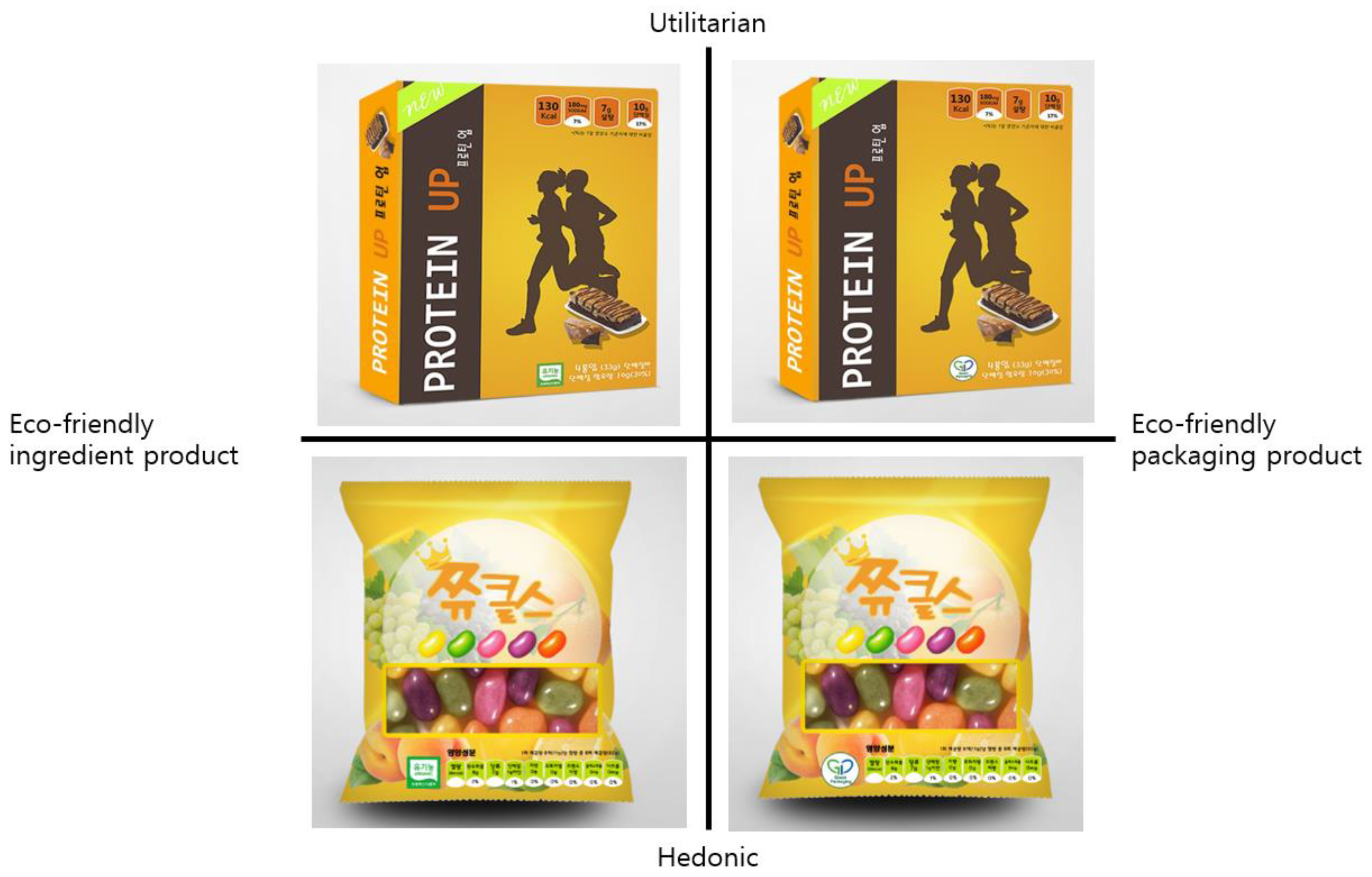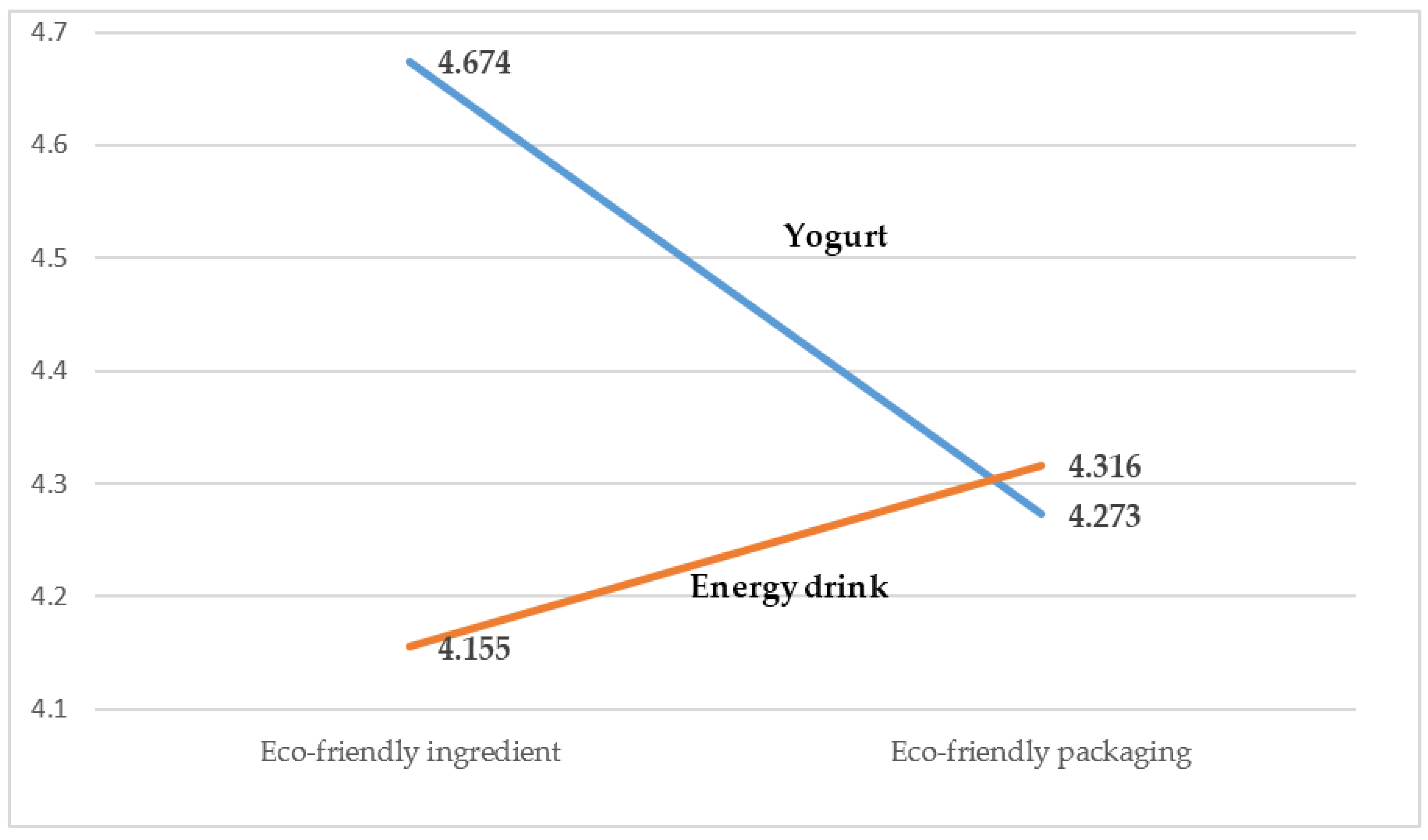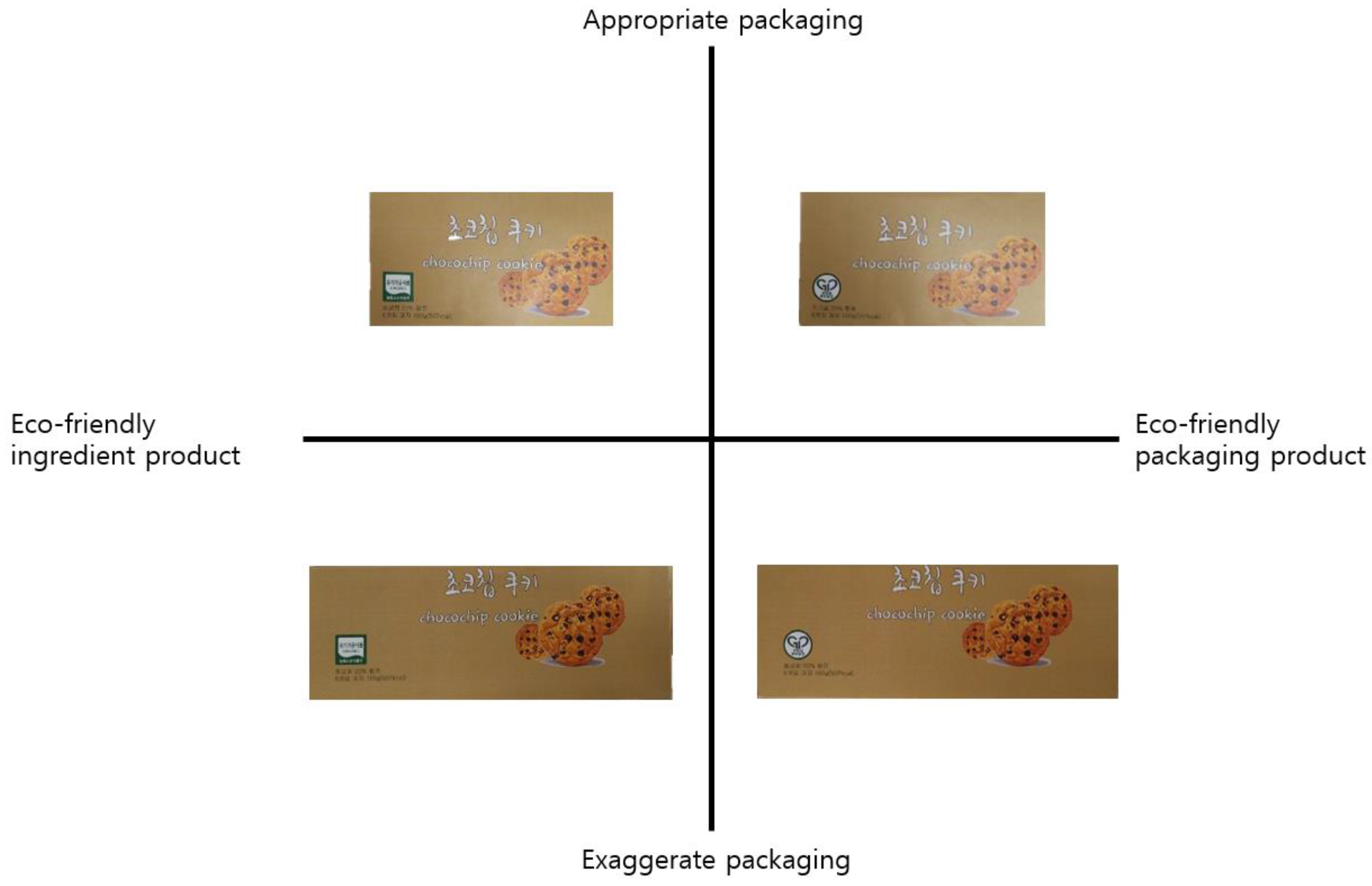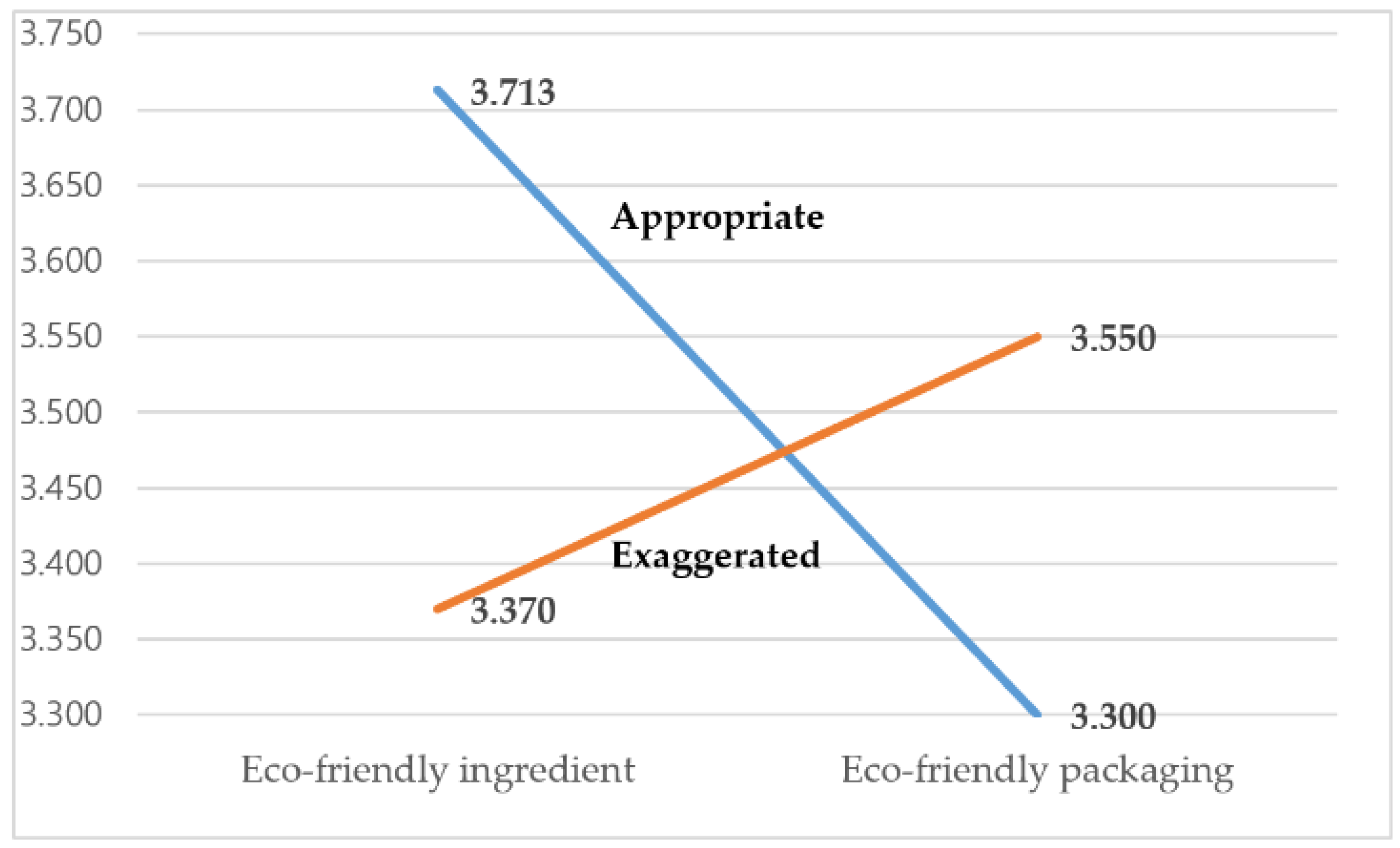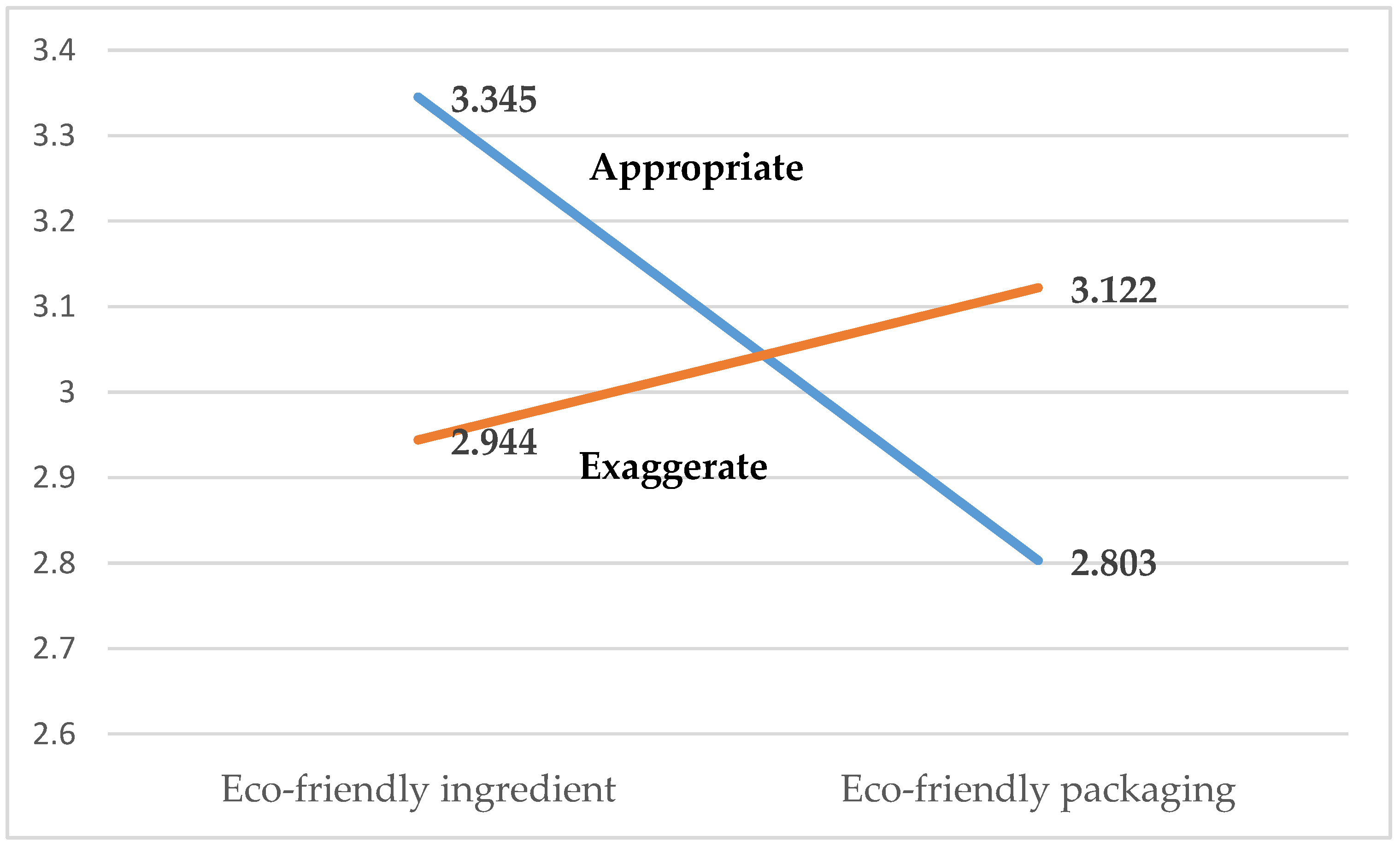1. Introduction
The market ratio of sustainable products is gradually increasing because environmental pollution has increased consumers’ concerns related to morality [
1] and a number of health scares and crises related to product safety. Due to these concerns (e.g., ethical issues and concerns for health), consumers have changed their behavior toward purchasing sustainable products. Many previous studies have shown that sustainable products have a competitive advantage over conventional products [
2]. A product’s sustainability, one type of information about the product, can be communicated to consumers via certification. Certification gives consumers confidence in the product’s value or safety [
3]. In the marketplace, we can find many kinds of certifications that indicate the sustainability of a product, especially for food products. Certifications of the sustainable attributes of sustainable food products can be divided into two parts [
4]. One involves the products’ internal sustainability (e.g., ingredient: organic, and Hazard Analysis and Critical Control Point-HACCP) while the second involves the products’ external sustainability (e.g., Fairtrade, and eco-friendly package). Eco-friendly products occupy most of the sustainable product market place [
5]. For this reasons, many companies make effort to distribute eco-friendly products. There are two typical and discrete methods of producing eco-friendly products: one is to make the product with eco-friendly ingredients and the other is to pack the product with eco-friendly packaging. Most producers supply eco-friendly products by using only one of the aforementioned methods, even though both of methods can be used. This is because of the production cost and the possibility that using eco-friendly components can change the product’s central traits like taste or other properties.
The eco-friendliness of eco-friendly ingredients is an internal attribute of product, as the eco-friendly ingredient is directly related to product itself. Most well-known eco-friendly ingredients are in organic products [
6]. Cognitively, consumers consider organic products beneficial and gentle for the environment and for health [
7,
8,
9]. This perception contributes to the added value of products, particularly food. Along these lines, many studies have explored the effect of organic products on consumers’ purchasing behavior [
10,
11]. In a previous study, organic information was found to increase consumer’s product evaluation more than conventional information, even if the products were the same [
12]. However, other previous findings have suggested that organic products are not always evaluated higher than conventional products [
13,
14,
15,
16]. This shows that the expectation for organic information can negatively affect the expectations for the product.
The eco-friendliness of eco-friendly packaging is an external attribute of the product, as packaging is an external element of product. Packaging is an indispensable element for sales [
17]. In recent years, however, packaging has been noted to be a cause of pollution; thus, the necessity for eco-friendly packaging is gradually growing [
18,
19]. Previous studies have shown that consumers prefer eco-friendly packed products over conventional products [
4,
19,
20]. Through previous studies we can see that the eco-friendliness of packaging makes products more valuable. Nevertheless, there are a few kinds of eco-friendly packaged products in the marketplace, and few studies have dealt with consumers’ attitude toward such products. Therefore, it is necessary to pay more attention to consumers’ preference for eco-friendly packaged products.
Another method to prevent the environment pollution caused by packaging is to use appropriate packaging. Consumers consider avoiding excessive packaged products as having more environmental benefits than other ecological food consumption, whereas they consider buying organic products as the least environmentally beneficial option [
21]. Packaging is the first element of a product consumers encounter before making their purchasing decision [
22]. The visual signals (e.g., size, color, and shape) of packages primarily affect consumers’ product evaluation [
23,
24]. Therefore, we can hypothesize that consumers primarily evaluate products’ sustainability via the level of packaging (appropriate vs. excessive).
Most existing studies have only focused on consumers’ preferences for organic food products, which are made with eco-friendly ingredients, and the understanding of consumers’ preference for eco-friendly food products remains limited. In addition, previous researchers have not investigated whether the eco-friendly packaged products have a comparative advantage over eco-friendly ingredient products. Moreover, investigations into whether consumers’ attitude towards eco-friendly products differs according to the level of packaging (appropriate vs. excessive) have not been conducted. In this study, through comparative studies of the eco-friendliness and product attributes regarding consumers’ purchase intentions, we investigated the effectiveness of imposing eco-friendly packaging to products when products’ attributes and the expectation for eco-friendly ingredients are not consistent.
In Studies 1 and 2, there are identical products with two different types of eco-friendliness that were given to each independent group. One of the products has a different attribute (e.g., hedonic vs. utilitarian). In
Figure 1, we examined the interaction effect between products’ attributes and eco-friendliness (Internal: eco-friendly ingredient vs. External: eco-friendly packaging) by examining the subjects’ willingness to buy (WTB) and the price premium, to highlight the importance of using proper sustainable attributes according to products’ attributes.
In Study 3 (
Figure 2), through an actual taste-evaluating experiment, we investigated whether consumers’ attitude toward eco-friendly products can differ according to the level of packaging (appropriate vs. excessive); the importance of using proper packaging material was highlighted. Similar to Studies 1 and 2, we assessed the interaction effect between eco-friendliness (Internal: eco-friendly ingredient vs. External: eco-friendly packaging) and the level of packaging (appropriate vs. exaggerated). At the end of this research, we conclude with a discussion of the theoretical and managerial implications of the findings.
2. Theoretical Background and Hypothesis
Most consumers have a positive attitude toward purchasing organic food products, and some purchase organic products on a regular basis [
8]. The definition of organic production is not uniform across all products [
25], and thus it is difficult to precisely define organic food products. The United States Department of Agriculture (USDA) defines organic production as a production system that avoids, or largely excludes, the use of synthetic chemicals and does not incorporate genetically modified products [
26]. Consumers link these attributes of organic products to healthiness, and therefore consumers prefer food products that provide information about the organic aspect [
7,
8,
9]. According to a previous study [
25], the definition of a sustainable product is unclear and it is not clearly defined whether organic products are sustainable or not; however, cognitively, consumers consider an organic food product that certified its internal eco-friendliness as more eco-friendly than conventionally produced food products. Traditionally, organic products have been recognized as beneficial not only for the environment, but also for personal health [
7,
8,
9]. Therefore, consumers consider organic products to be reputable products [
6], and they expect organic products to be healthy and environmentally friendly. Sörqvist et al. [
12] found that even if the ingredients in coffee are the same, subjects exhibited a higher purchase intention and sensory evaluation to one kind of coffee when they were informed that it was organic. This means that consumers have expectations for the organic information and this added positively to their expectations for the conventional product. However, previous studies have suggested that organic products are not always evaluated more highly than conventional products [
13,
14,
15]. Lee et al. [
14] found that consumers give a higher taste evaluation for organic yogurts than for conventional yogurts, however, they found that consumers give a lower taste evaluation for organic cookies than regular ones. Luchs et al. [
13] found that organic products are not always preferred. They estimated consumers’ intention to purchase organic products (vs. conventional products), such as baby shampoo and car wash shampoo, the attributes of which are related to gentleness and strength, respectively. As a result, they found that consumers have a tendency to evaluate their preference for sustainable products as lower than their preference for conventional products when the product’s attribute is related to strength (vs. gentleness). This is because organic products made with eco-friendly ingredients are perceived as less effective by consumers [
16]. In summary, the eco-friendliness of an organic product—internal attribute—is directly related to the product itself; however, this can be a negative or positive factor according to the product’s attributes.
Another aspect of sustainable food products is that they exist in the marketplace as products with eco-friendly packaging. Because packaging is an extrinsic element of products, it does not affect the products themselves [
27]; therefore, the eco-friendliness of packaging is not directly related to a product itself. According to Svanes et al. [
28], eco-friendly packaging can be described as packaging that has the general functions of a package, produced with eco-friendly materials (made with minimal recyclable and biodegradable materials), and is economically sustainable. The general functions of packaging are as follows. Packaging prevents damage that can occur during distribution [
29]. Packaging is an indispensable element in product sales because it gives specific information about a product [
30]. Packaging catches the consumer’s eye, and it can affect the consumer’s purchase intentions. Packaging has an impact on consumers’ evaluation of the product; when packaging is well made, it can elicit a positive evaluation of a product. According to Rokka and Uusitalo [
19], eco-friendly packaging was the second priority for consumers, while the first priority was product functionality. Magnier and Schhormans [
20] found that the visual and verbal cues of packages’ sustainability foster significant environmental concerns, as consumers’ intentions were to purchase sustainable food products. Magnier et al. [
4] also found that whether a product is considered a healthy food (raisins) or an unhealthy food (chocolate bar), the perceived quality of an eco-friendly packaged product was higher than a conventionally packed product. This presupposes that eco-friendly packaging has benefits that increase a product’s value. Through previous studies, we can notice that eco-friendly packaging does not affect a product’s attributes, therefore it does not have a direct influence on product evaluation, however, this factor positively and indirectly influences the overall evaluation.
In summary, two types of eco-friendly products (eco-friendly ingredient product vs. eco-friendly packaging product) have different attributes; the eco-friendliness of an eco-friendly ingredient product is an internal attribute. The expectations for eco-friendly ingredient products are directly related to the consumers’ expectations for conventional products. When the expectations for eco-friendly ingredient products and expectations for conventional products are inconsistent, an expectancy disconfirmation [
31] occurs. Consumers’ preference for eco-friendly ingredient products will be lower than the preferences for conventional products. Unlike eco-friendly ingredient products, the eco-friendliness of eco-friendly packaging is an external attribute. The expectations for eco-friendly packaging indirectly relates to the consumers’ expectations for the conventional products. Therefore, the expectations for eco-friendly packaging do not affect the expectations for conventional products.
Food becomes a part of the body after it is ingested. Therefore, consumers have a tendency to focus on the healthfulness of food when they are eating it [
32]. Consumers also focus on a food’s hedonic characteristics. Food products can be distinguished as either utilitarian or hedonic. Consumers have expectations of utilitarian food products to be healthful, functional, and energetic, while they expect hedonic foods to be delicious and enjoyable [
33]. Utilitarian food products are consumed for cognitive and functional purposes [
34]. These purposes are similar to the purposes of consuming an organic food product, and the expectations of organic products are also congruent with utilitarian expectations. Thus, according to expectancy confirmation theory [
31], it can be predicted that consumers will have a higher WTB for organic utilitarian food products than for eco-friendly packaged ones. Chocolate chip cookies, for example, tend to be an example of a hedonic food product, consumed based on their taste, texture, and visual beauty [
35]. Consumers regard organic chocolate chip cookies as less tasty than conventional ones [
14]. According to Magnier et al. [
4], consumers preferred the eco-friendly packed chocolate bar which is strongly related to hedonic than conventional. According to the previous studies, we can hypothesize that when the expectations for products are congruent with the expectations for eco-friendly ingredient, consumers will prefer eco-friendly ingredient products over eco-friendly packaged products because generally consumers have higher preference for eco-friendly ingredient products. However, when the expectations are incongruent, they will prefer the conventional products. Consequently, their preference for each product will be linked to their willingness buy (WTB) and the price premium [
36,
37]. Therefore, consumers’ WTB and the price premium will be higher with the eco-friendly ingredient utilitarian products than the eco-friendly packaged utilitarian products because the expectations for utilitarian products are congruent with the expectations for eco-friendly ingredient products. Meanwhile, expectations for the hedonic products are incongruent with the expectations for the eco-friendly ingredient products, therefore the preference for eco-friendly ingredient hedonic products will be lower than the preference for eco-friendly packed hedonic products, because in previous study, eco-friendly packed products were evaluated as more attractive than conventional ones. Therefore, Hypothesis 1 and Hypothesis 2 were established as follows:
H1: Consumers’ WTB and price premium are higher for products with eco-friendly ingredients (vs. eco-friendly packaging) when a product is utilitarian.
H2: Consumers’ WTB and price premium are higher for products with eco-friendly packaging (vs. eco-friendly ingredients) when a product is hedonic.
Consumers also have different cognitive expectations for products according to their attributes. According to Luchs et al. [
13], consumers expect a product whose attributes are related to gentleness to be safe, healthy, good for children, and mild. In contrast, they expect a product whose attributes are related to strength to be strong, powerful, tough, effective, and get the job done. Based on these previous studies, we can assume that consumers’ WTB for eco-friendly ingredient products is higher (vs. eco-friendly packaged products) in instances in which the products’ attributes are related to gentleness (vs. strength). On the contrary, however, consumers’ WTB for eco-friendly packaged product (vs. eco-friendly ingredient product) is higher in cases in which the products’ attributes are related to strength (vs. gentleness) because of expectancy disconfirmation. Accordingly, we formulated the following hypotheses:
H3: Consumers’ WTB and price premium are higher for products with eco-friendly ingredients (vs. eco-friendly packaging) when a product’s attributes are related to gentleness.
H4: Consumers’ WTB and price premium are higher for products with eco-friendly packaging (vs. eco-friendly ingredients) when a product’s attributes are related to strength.
Packaging can be categorized into three types: primary packaging, secondary packaging, and tertiary packaging [
17]. As seen in snack packaging, primary packaging contains only the product, whereas secondary packaging contains the primary packaging. Secondary packaging may be discarded immediately when consumers use the product. Finally, tertiary packaging is used for bulk handling and warehouse storage. Food packaging has two characteristics: it contains the product and it is thrown away immediately after the food product has been consumed. Currently, about 50% of discarded packaging is food packaging [
29]. For environmental reasons, it is necessary to reduce the disposal of food packaging. Therefore, the ness to use eco-friendly packaging is growing worldwide. However, the use of eco-friendly packaging increases production costs. Therefore, a basic method to prevent the environmental pollution that can be caused by packaging is to use appropriate packaging. According to Tobler et al. [
21], consumers regard the avoidance of excessive-packaged products as the most environmentally beneficial, even greater than other ecological food consumption, whereas they consider buying organic products the least environmentally beneficial. Packaging is the first element encountered when consumers see a product before making their decision [
22]. The visual signals (size, color, and shape) of the package primarily affect consumers’ product evaluation [
23]. Accordingly, we can assume that consumers primarily evaluate a product’s eco-friendliness on the level of packaging, whether it is packaged excessively or not. However, in some cases, the high prices of organic products and the attitude to maximize profits leads to excessive packaging, which appears to contain a lot of content. This can generate expectancy disconfirmation [
31], as excessive packaging is not considered environmentally friendly. Meanwhile, following the property of products, the use of buffer packaging to protect the products from damage is needed. However, because consumers view excessive packaging negatively, consumers evaluate the buffer packaged products negatively. However, the information that buffer packaged products are made with eco-friendly packaging can prevent consumers’ negative evaluation of them.
In summary, regarding purchase intention, eco-friendly ingredient products are judged less favorably when packaged with excessive packaging because of expectancy disconfirmation, consumers link high ethical standards to organic products; therefore, exaggerated packaging will be evaluated more negatively than appropriately packed organic products. However, when a product with eco-friendly packaging is packed in an exaggerated manner, cognitive dissonance [
38] occurs. Consumers evaluate an exaggeratedly packed eco-friendly packaged product more highly than an appropriately packed one. Eventually, these evaluations will link to WTB and the price premium, based on this, Hypothesis 5 and Hypothesis 6 were established as follows:
H5: Consumers’ preference, product evaluation, satisfaction, WTB, and price premium are higher for cookies packed in an appropriate manner (vs. exaggerated manner) when they are organic cookies.
H6: Consumers’ preference, product evaluation, satisfaction, WTB, and price premium are higher for cookies packed in an exaggerated manner (vs. appropriate manner) when they are packed in eco-friendly packaging.
6. Discussion
Through experiments, this study investigated consumers’ WTB and price premium for two types of eco-friendly products. The main purpose of Study 1 and Study 2 was to investigate whether the consumers’ WTB and price premium for sustainable products would differ based on the product’s sustainability attributes (i.e., internal: eco-friendly ingredient-organic vs. external: eco-friendly packaging-green packaging) and product attributes (i.e., utilitarian vs. hedonic, and gentleness-related vs. strength-related).
In summary, the results of both studies (Study 1 and Study 2) indicated that according to eco-friendliness and product attributes, consumers’ WTB for product can differ. As expected, consumers have a tendency to prefer eco-friendly ingredient utilitarian products (i.e., organic protein bar) to eco-friendly packaged utilitarian products because consumers tend to consider an eco-friendly ingredient product as healthier than a conventional product. Therefore, because of expectancy confirmation, consumers’ WTB rose. Moreover, in this study, we found that consumers’ preference for an eco-friendly packaged (eco-friendly packaging) hedonic product (i.e., eco-friendly packed jelly beans) was higher than the preference for an eco-friendly ingredient hedonic product (i.e., eco-friendly ingredient jelly beans). This is because there is a tendency for the eco-friendly ingredient factor (internal attribute of product) to reduce cognitive effectiveness, which is the taste of a product’s attributes. As in Study 1, in Study 2, participants had a greater WTB for eco-friendly ingredient (organic, which is the internal eco-friendliness of a product) yogurt (gentleness related product) over eco-friendly packaged (eco-friendly packaging, which is the external eco-friendliness of a product) yogurt because consumers consider organic products to be healthier and safer than conventional ones. In contrast, they had lower evaluations of WTB for eco-friendly ingredient energy drinks (strength related product) than eco-friendly packaged energy drinks because of expectancy disconfirmation. The expectations for energy drinks (strong, powerful, and effective) were not congruent with the expectations for eco-friendly ingredient products.
Moreover, in Study 3, consumers’ WTB and price premium for sustainable products differed in accordance with eco-friendliness (internal: ingredients vs. external: packaging) and with packaging level (appropriate vs. excessive). Consumers’ WTB for appropriately packaged cookies with eco-friendly ingredients was higher than for those with exaggerated packaging also due to expectancy disconfirmation. The cookies with eco-friendly ingredients that were packaged in an exaggerated manner diminished the participants’ confidence (feeling of safety) in the eco-friendly ingredient product, which is one of the reasons why consumers buy eco-friendly ingredient food products. Participants’ WTB and satisfaction between eco-friendly packaged cookies that are packaged in an exaggerated manner shows higher WTB and satisfaction than appropriate packaging, which can be explained by the cognitive dissonance theory.
7. Limitations and Implications
This study has several limitations. First, in Study 2, we did not control the balance of the participants’ gender, nor did we assess their daily preference and the frequency of yogurt (vs. energy drink) consumption. Second, in Study 3, all participants were students and the gender balance was not controlled. Third, this study was conducted in a laboratory, and thus there may be some gaps between the actual market and the small sample size analyzed in the laboratory. Fourth, in Study 3, consumers’ attitude towards appropriately or exaggerated non-eco-friendly packaged packaging was not checked. Fifth, we did not check the consumers’ WTB and price premium toward products that have both eco-friendly ingredient and eco-friendly packaging. Finally, we used only two stimuli each in Studies 1 and 2, and one stimulus in Study 3. Therefore, we hope that future research will extend this study’s results by simultaneously considering other kinds of food products and product attributes.
Currently, the importance of sustainable products is rapidly increasing because of environmental pollution. However, there has been little research into sustainable products and most research with regards to eco-friendly products have been focused on organic products. Therefore, the understanding of consumers’ attitude toward sustainable products is still insufficient. This study provided different results from previous studies. In this study, through experimentation, we investigated not only consumers’ WTB for different kinds of eco-friendly ingredient products, but also their WTB for different kinds of eco-friendly packaged products. The results of this study have academic and practical implications.
Academically, this study makes several theoretical contributions to the literature. The findings expanded the consequence of consumers’ purchasing behavior toward sustainable products. As in previous research [
13,
14], we conducted an experiment and identified not only consumers’ attitudes toward eco-friendly ingredient (organic) or eco-friendly packaged products, but also the interaction effect between a product’s attribute and eco-friendliness. By investigating the interaction effect, we found that when the product’s attribute is related to hedonic and strength factors, the eco-friendliness of the packaging increases consumers’ WTB more than the eco-friendly ingredients. In addition, in Study 3, we found that not only eco-friendliness, but also the level of packaging can influence consumers’ WTB. The results of Study 3 enhance the understanding of the effect of packaging, which is the visual element of a product, on consumers’ food choices.
Practically, the results of this study have implications for producers. When manufactures develop and update their products, they consider the eco-friendliness of product because of environmental protection and profit maximization. Many kinds of eco-friendly ingredient products exist in the marketplace, and many of them were developed without consideration of the product’s own attributes. The results of this study indicated that the utility-related and gentleness-related products should be developed as eco-friendly ingredient rather than as eco-friendly packaged products. The results of this study also indicated that hedonic-related and strength-related products should be developed as eco-friendly packaged rather than as eco-friendly ingredient products. Making and updating products into eco-friendly ingredient product can expend high costs and can risk harming or changing the product’s central traits like taste or properties. Therefore, when food producers develop products, they should consider both the eco-friendliness and the product attributes. If using eco-friendly ingredients harm the product’s central traits (when expectancy disconfirmation occurs), using eco-friendly packaging as an alternative to using eco-friendly ingredients can help protect the environment and maximize profits. Moreover, producers hesitate to update conventional products to sustainable products, as mentioned above, because using eco-friendly ingredients can harm the products’ central trait. However, eco-friendly packaging is an external attribute of the products; therefore updating conventional product with eco-friendly packaging can be a solution. However, commonly, most eco-friendly packaged products in the marketplace appear as recycled cardboard. Therefore, producers hesitate to update conventional products to eco-friendly packaged ones because change in the visual cues of products can harm the products’ identity. Through Studies 1 and 2, we found that information about the eco-friendliness of packaging informed by certification can increase consumers’ WTB. Therefore, updating conventional products’ packaging to eco-friendly packaging that is certified with no changes in visual cues is one potential solution. In addition, when designing packaging, companies should consider how the level of packaging influences sales. The visual cues of products informed by packaging primarily affect consumers’ product evaluation. When it comes to packaging, highly valued organic products need more consideration in terms of packaging level because excessive packaging can harm the products’ evaluation. Excessive packaging also diminishes consumers’ confidence of product. When it is necessary to use buffer packaging, companies should consider eco-friendly packaging to maximize revenue, consumers’ satisfaction, and environmental protection. These developments will increase consumers’ WTB for sustainable products and will have positive effects on environmental protection and product revenues. Furthermore, these actions will help promote the implementation of corporate accountability and improve the company’s public image. If sustainable attributes have a negative effect on products, they can harm the product’s brand identity.
